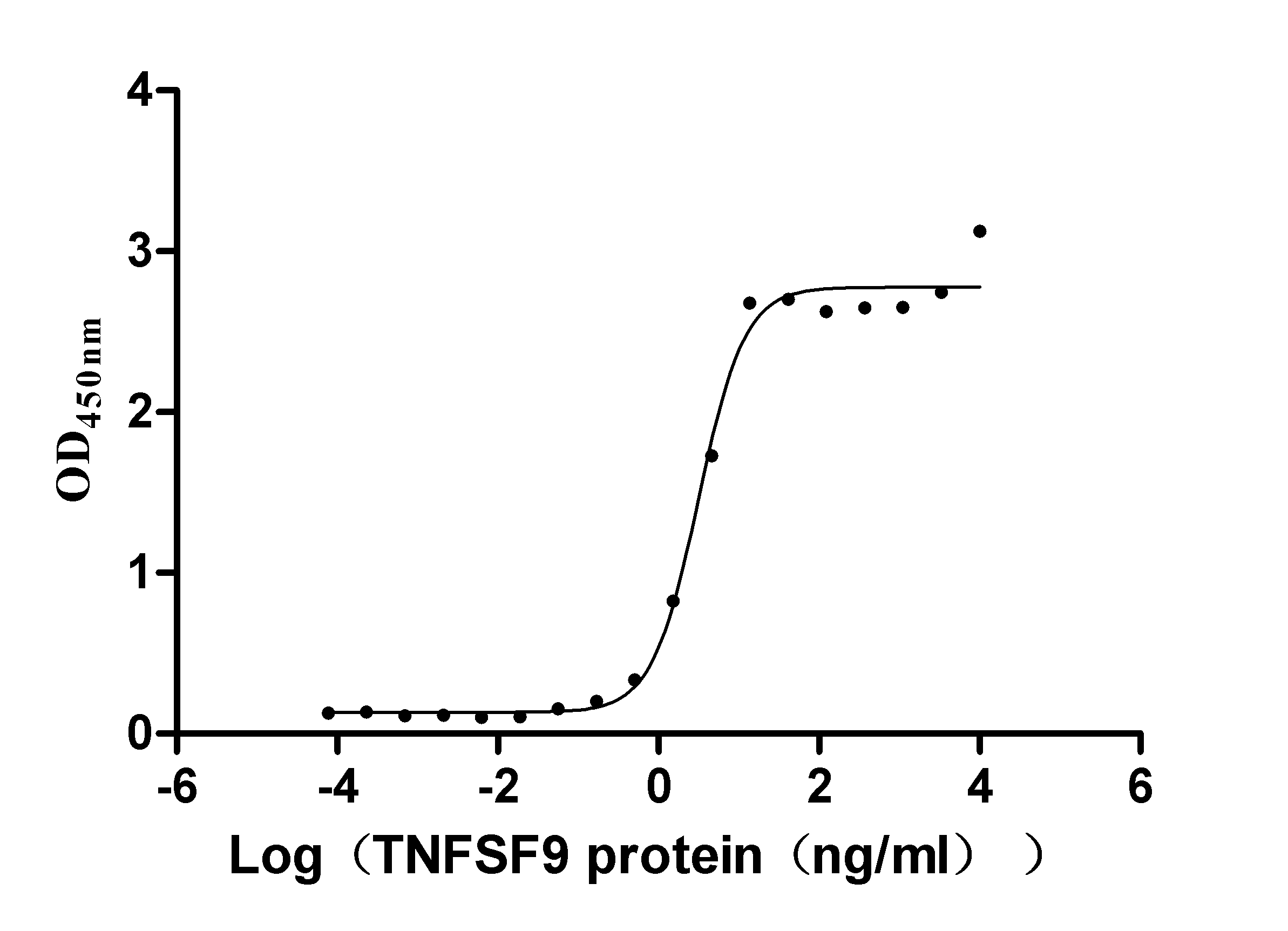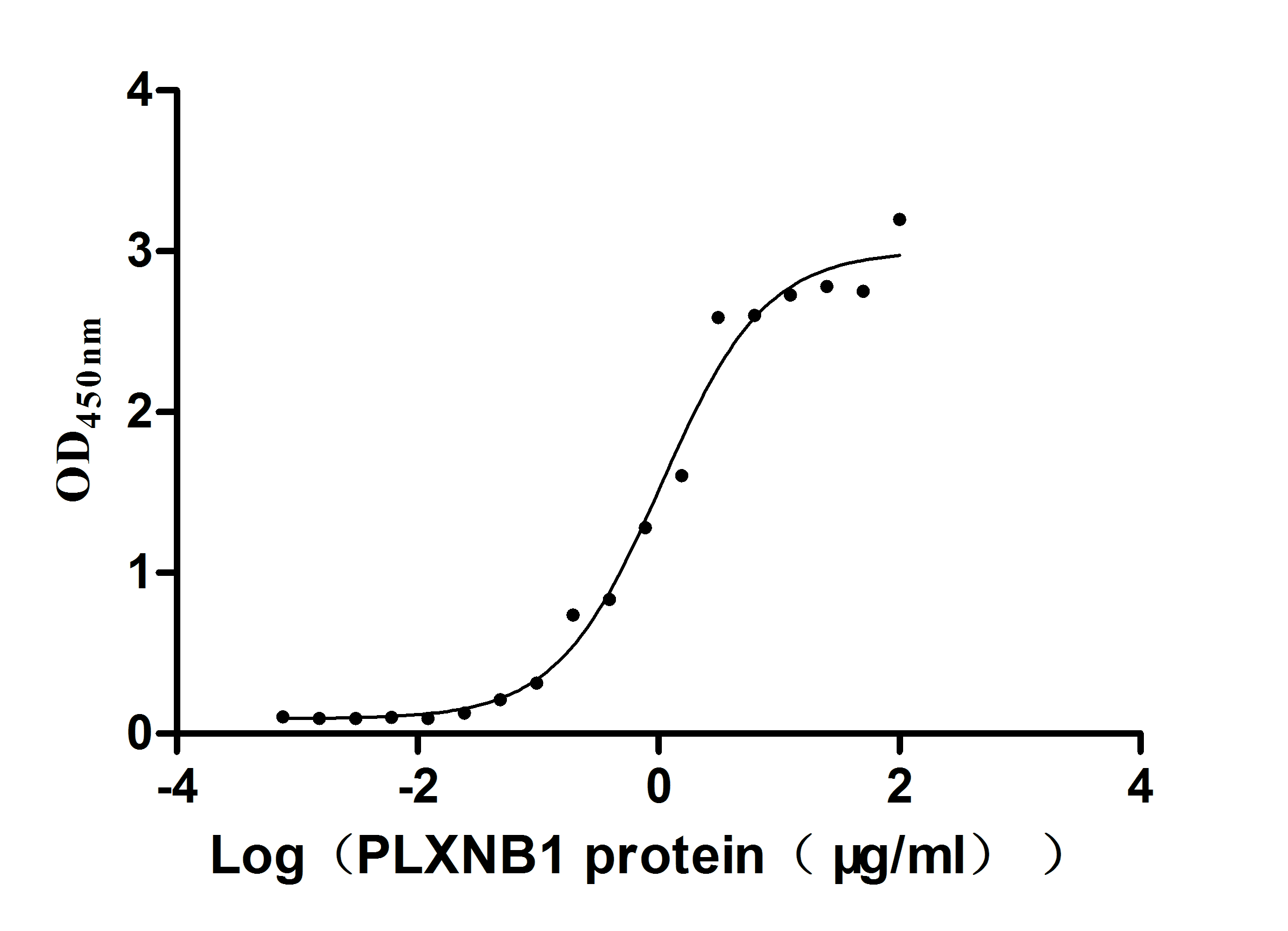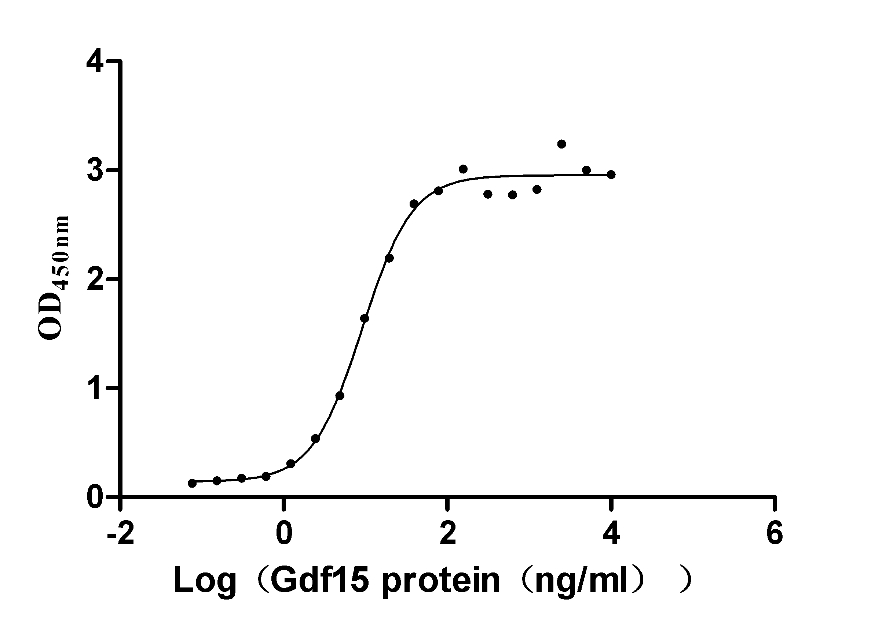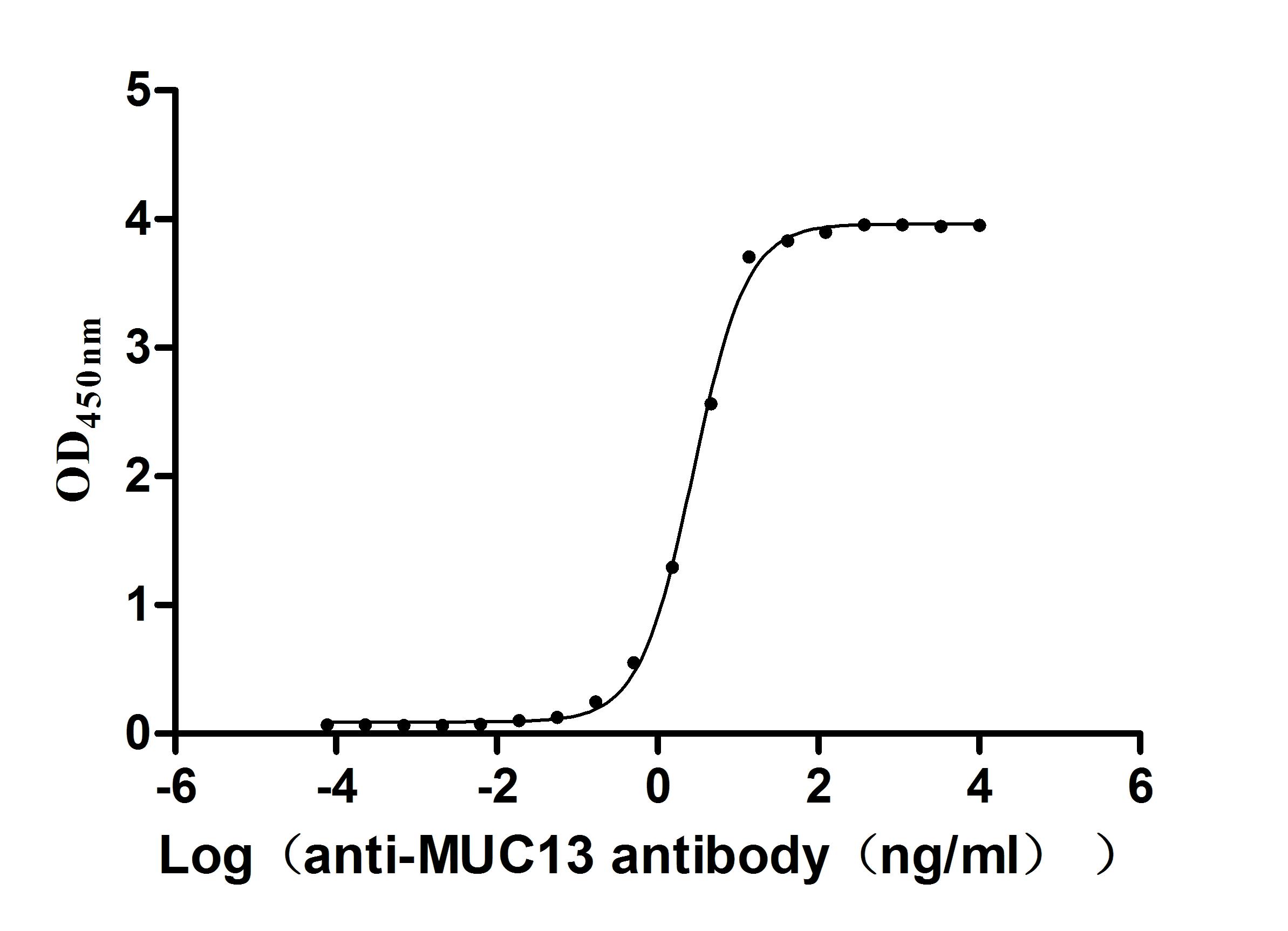Recombinant Rat Mitogen-activated protein kinase 1 (Mapk1)
-
货号:CSB-YP013448RA
-
规格:
-
来源:Yeast
-
其他:
-
货号:CSB-EP013448RA
-
规格:
-
来源:E.coli
-
其他:
-
货号:CSB-EP013448RA-B
-
规格:
-
来源:E.coli
-
共轭:Avi-tag Biotinylated
E. coli biotin ligase (BirA) is highly specific in covalently attaching biotin to the 15 amino acid AviTag peptide. This recombinant protein was biotinylated in vivo by AviTag-BirA technology, which method is BriA catalyzes amide linkage between the biotin and the specific lysine of the AviTag.
-
其他:
-
货号:CSB-BP013448RA
-
规格:
-
来源:Baculovirus
-
其他:
-
货号:CSB-MP013448RA
-
规格:
-
来源:Mammalian cell
-
其他:
产品详情
-
纯度:>85% (SDS-PAGE)
-
基因名:
-
Uniprot No.:
-
别名:Mapk1; Erk2; Mapk; Prkm1; Mitogen-activated protein kinase 1; MAP kinase 1; MAPK 1; EC 2.7.11.24; ERT1; Extracellular signal-regulated kinase 2; ERK-2; MAP kinase isoform p42; p42-MAPK; Mitogen-activated protein kinase 2; MAP kinase 2; MAPK 2
-
种属:Rattus norvegicus (Rat)
-
蛋白长度:Full Length of Mature Protein
-
表达区域:2-358
-
氨基酸序列AAAAAAGPE MVRGQVFDVG PRYTNLSYIG EGAYGMVCSA YDNLNKVRVA IKKISPFEHQ TYCQRTLREI KILLRFRHEN IIGINDIIRA PTIEQMKDVY IVQDLMETDL YKLLKTQHLS NDHICYFLYQ ILRGLKYIHS ANVLHRDLKP SNLLLNTTCD LKICDFGLAR VADPDHDHTG FLTEYVATRW YRAPEIMLNS KGYTKSIDIW SVGCILAEML SNRPIFPGKH YLDQLNHILG ILGSPSQEDL NCIINLKARN YLLSLPHKNK VPWNRLFPNA DSKALDLLDK MLTFNPHKRI EVEQALAHPY LEQYYDPSDE PIAEAPFKFD MELDDLPKEK LKELIFEETA RFQPGYRS
-
蛋白标签:Tag type will be determined during the manufacturing process.
The tag type will be determined during production process. If you have specified tag type, please tell us and we will develop the specified tag preferentially. -
产品提供形式:Lyophilized powder
Note: We will preferentially ship the format that we have in stock, however, if you have any special requirement for the format, please remark your requirement when placing the order, we will prepare according to your demand. -
复溶:We recommend that this vial be briefly centrifuged prior to opening to bring the contents to the bottom. Please reconstitute protein in deionized sterile water to a concentration of 0.1-1.0 mg/mL.We recommend to add 5-50% of glycerol (final concentration) and aliquot for long-term storage at -20℃/-80℃. Our default final concentration of glycerol is 50%. Customers could use it as reference.
-
储存条件:Store at -20°C/-80°C upon receipt, aliquoting is necessary for mutiple use. Avoid repeated freeze-thaw cycles.
-
保质期:The shelf life is related to many factors, storage state, buffer ingredients, storage temperature and the stability of the protein itself.
Generally, the shelf life of liquid form is 6 months at -20°C/-80°C. The shelf life of lyophilized form is 12 months at -20°C/-80°C. -
货期:Delivery time may differ from different purchasing way or location, please kindly consult your local distributors for specific delivery time.Note: All of our proteins are default shipped with normal blue ice packs, if you request to ship with dry ice, please communicate with us in advance and extra fees will be charged.
-
注意事项:Repeated freezing and thawing is not recommended. Store working aliquots at 4°C for up to one week.
-
Datasheet :Please contact us to get it.
靶点详情
-
功能:Serine/threonine kinase which acts as an essential component of the MAP kinase signal transduction pathway. MAPK1/ERK2 and MAPK3/ERK1 are the 2 MAPKs which play an important role in the MAPK/ERK cascade. They participate also in a signaling cascade initiated by activated KIT and KITLG/SCF. Depending on the cellular context, the MAPK/ERK cascade mediates diverse biological functions such as cell growth, adhesion, survival and differentiation through the regulation of transcription, translation, cytoskeletal rearrangements. The MAPK/ERK cascade plays also a role in initiation and regulation of meiosis, mitosis, and postmitotic functions in differentiated cells by phosphorylating a number of transcription factors. About 160 substrates have already been discovered for ERKs. Many of these substrates are localized in the nucleus, and seem to participate in the regulation of transcription upon stimulation. However, other substrates are found in the cytosol as well as in other cellular organelles, and those are responsible for processes such as translation, mitosis and apoptosis. Moreover, the MAPK/ERK cascade is also involved in the regulation of the endosomal dynamics, including lysosome processing and endosome cycling through the perinuclear recycling compartment (PNRC); as well as in the fragmentation of the Golgi apparatus during mitosis. The substrates include transcription factors (such as ATF2, BCL6, ELK1, ERF, FOS, HSF4 or SPZ1), cytoskeletal elements (such as CANX, CTTN, GJA1, MAP2, MAPT, PXN, SORBS3 or STMN1), regulators of apoptosis (such as BAD, BTG2, CASP9, DAPK1, IER3, MCL1 or PPARG), regulators of translation (such as EIF4EBP1) and a variety of other signaling-related molecules (like ARHGEF2, DCC, FRS2 or GRB10). Protein kinases (such as RAF1, RPS6KA1/RSK1, RPS6KA3/RSK2, RPS6KA2/RSK3, RPS6KA6/RSK4, SYK, MKNK1/MNK1, MKNK2/MNK2, RPS6KA5/MSK1, RPS6KA4/MSK2, MAPKAPK3 or MAPKAPK5) and phosphatases (such as DUSP1, DUSP4, DUSP6 or DUSP16) are other substrates which enable the propagation the MAPK/ERK signal to additional cytosolic and nuclear targets, thereby extending the specificity of the cascade. Mediates phosphorylation of TPR in response to EGF stimulation. May play a role in the spindle assembly checkpoint. Phosphorylates PML and promotes its interaction with PIN1, leading to PML degradation. Phosphorylates CDK2AP2.; Acts as a transcriptional repressor. Binds to a [GC]AAA[GC] consensus sequence. Repress the expression of interferon gamma-induced genes. Seems to bind to the promoter of CCL5, DMP1, IFIH1, IFITM1, IRF7, IRF9, LAMP3, OAS1, OAS2, OAS3 and STAT1. Transcriptional activity is independent of kinase activity.
-
基因功能参考文献:
- ERK that interacts with and phosphorylates mGluR1a is involved in the regulation of the trafficking and signaling of mGluR1. PMID: 27796752
- Study predicted the structure of the MAPK1-vinculin binding interface using a combination of flexible docking and molecular dynamics simulations, and confirmed that the MAPK1-vinculin interaction is mechanically regulated, and implicated a change in the vinculin D3-D4 cleft size upon vinculin activation as the basis for the conformational selectivity of MAPK1 binding toward open vinculin. PMID: 28494959
- Mirtazapine suppressed 5-HT-mediated TGF-beta1/Smad3 and ERK1/2 signaling pathways as well as oxidative stress that contribute to the progression of liver fibrosis. PMID: 28623179
- Collectively, the data imply that TRH-induced depolarization and inward current in PVT neurons involve both a dependency on extracellular Ca(2+) influx via opening of L-type Ca(2+) channels, a sensitivity of a TRPC-like component to intracellular Ca(2+) release via ryanodine channels, and a modulation by MAPK of a GIRK-like conductance component. PMID: 27009047
- MAPK1 was able to increase the proliferation of cardiomyocytes via up-regulating the expression of MALAT1 through PI3K/AKT signaling pathway. PMID: 26884868
- This study showed that sharp increases in phosphorylated or activated ERK2 was observed at postnatal day (PND) 7 in the SN and VTA. In contrast, in the STR, the levels of phosphorylated ERK2 was significantly higher at postnatal 0 day. PMID: 26363522
- An interaction between MAPK signaling and ER stress in cardiovascular regions of the brain may contribute to the development of HF. PMID: 26573710
- -protein-coupled receptor 30 (GPR30) and estrogen receptor alpha (ERalpha) is required for the action of peptide ERalpha17p activation of ERK1/2 (extracellular-signal-regulated kinase 1/2). PMID: 26371374
- Immediately after the 1-h restraint, c-Fos and p-ERK expression increased in all structures studied, particularly in PVN and LC. PMID: 24567082
- A set of methyl probes was used to quantify binding affinity and kinetics of an Elk1D peptide and an ATP analogue to the inactive and active ERK2. The peptide showed local effects in the protein. The nucleotide binding induced long-range effects. PMID: 26132046
- ERK2 mediates growth arrest and differentiation independently of the conventional ERK-target interaction mechanism PMID: 25639353
- Results suggest that the selective ERK2 activation in basolateral amygdala following stress exposure is an important mechanism for the occurrence of the promoting influence of stress on fear memory and on anxiety-like behavior PMID: 24182621
- It plays a distinct role in proliferation, differentiation, and neuronal viability. PMID: 24411019
- It plays a key, mediating role in disease states, characterized by inflammaion. PMID: 24228599
- Phosphorylation and activation of ERK2 lead to a dramatic shift in conformational exchange dynamics, likely through release of constraints at the hinge. PMID: 24550275
- Anti-ERK2 gene therapy modulates the mechanisms, protecting allografts against transplant arteriosclerosis. PMID: 23498803
- Activation of CaMKII-ERK1/2 signaling in the hippocampal CA1 and dentate gyrus may play an important role in alcohol dependence PMID: 22960015
- the structures of apo-form ERK2 and of its complexes with the substrate ATP and the product ADP were determined. PMID: 23192020
- The sexually dimorphic expression of ERK2 mediates social anxiety-like behaviors. PMID: 22521590
- These findings imply that TH activation of the ERK1/2 signal pathway could play an important role in ouabain-induced hyperactivity of rats, a mania model. PMID: 21871514
- results implicate a role for ERK2 signaling within the dentate gyrus area of the hippocampus as a key mediator of the antidepressant effects of testosterone. PMID: 22265242
- MEK1/ERK2 signaling pathway is required for nontypeable H. influenzae-induced CXCL2 upregulation in the rat spiral ligament fibrocytes. PMID: 22379036
- Contact with outgrowing axons after immediate nerve repair results in activation of ERK2. PMID: 21251262
- Extracellular signal-regulated protein kinase 2 phosphorlation activity is increased following compressive injury of the cerebral cortex. PMID: 20568963
- NMR analysis of into docking interactions involving inactive ERK2 PMID: 21449613
- Erk2 (and Erk1) activation in pedunculopontine tegmental cells is associated with sleep maintenance via suppression of wakefulness. PMID: 21166678
- ET-1 induces smooth muscle cell migration, with the ETA receptor tightly coupled to ERK1/2 phosphorylation, only in the pulmonary but not the aortic circulation. PMID: 20725141
- These data suggest a role for ERK signaling in the dorsal striatum during learning and suggest that processes sensitive to ERK signaling within these striatal subregions interact to control performance after initial acquisition. PMID: 20181592
- identification of point mutations that selectively disrupt binding to MEK1 PMID: 11823456
- The activity of the extracellular signal-regulated kinase 2 is regulated by differential phosphorylation in the activation loop. PMID: 11839761
- noradrenaline caused a time-dependent activation of ERK2 in mesenteric arteries PMID: 11844932
- Ang II-induced ERK1/2 activation in C9 hepatocytes is independent AT1-Receptor endocytosis PMID: 11875120
- role in downregulation of tropoelastin mRNA in lung fibroblasts PMID: 11889128
- Lysophosphatidylcholine activates extracellular signal-regulated kinase 2 through reactive oxygen species in vascular smooth muscle cells. PMID: 12006386
- ERK2 is regulated by the dopaminergic D2 receptor in the rat pituitary PMID: 12121979
- mediates serotonin-induced MMP-13 production in rat uterine smooth muscle cells PMID: 12213812
- growth factor induced phosphorylation of glomerular ERK2 is reduced by bradykinin PMID: 12388422
- The direct activation of ERK2 in ventral tegmental area slices by the mu-opioid agonist fentanyl may suggest a role of extracellular signal-regulated protein kinase in reward processes. PMID: 12535947
- Pressure-induced activation of extracellular signal-regulated kinase 2 in mesenteric small arteries. PMID: 12623863
- study indicates that a glucose-induced rise in calcium leads to cAMP-induced activation of protein kinase A to mediate Erk-1/2 phosphorylation activation in pancreatic beta-cells PMID: 12663469
- new pathway of Src family kinase-dependent thrombin-stimulated ERK1/2 phosphorylation that is independent of EGFR and PKC activation in vascular smooth muscle PMID: 12730054
- The ERK2 signal pathway is critical in angiotensdin II-dependent smooth muscle endothelial cell division. PMID: 12837289
- In vitro stimulation of either H2 or H3 histaminergic receptors activates ERK2 in hippocampal CA3 pyramidal cells; early ERK2 hippocampal activation is not required for the expression of long-term fear memories PMID: 14534235
- Diurnal variation in p42 mitogen-activated protein kinase phosphorylation in the rat pineal gland. PMID: 14580718
- results suggest that PEA-15 sequesters ERK2 in the cytoplasm at least in part by interfering with its ability to interact with nucleoporins, presenting a potential paradigm for regulation of ERK2 localization PMID: 14707138
- SAP90 is a novel substrate for ERK2, which phosphorylates SAP90 at Thr287 & Ser290 in vitro, but this does not require PDZ-dependent binding. PMID: 14741046
- In aldosterone/salt hypertensive rats, renal injury was associated with increases in ERK2 activity in the renal cortical tissues. ROS and MAPK play a role in the progression of renal injury induced by chronic elevations in aldosterone. PMID: 14769808
- The amount of phospho-p38 was not altered by ischemia under both normo- and hyperglycemic conditions, suggesting that p38 MAPK may not play a major role in mediating neuronal damage in the neocortex and dentate gyrus PMID: 14983993
- itogen-activated protein kinase and extracellular-signal-regulated kinase1/2 were found to participate in the estrogen-mediated changes in the cholinergic phenotype. PMID: 15026121
- Results support the hypothesis that the ERK-signaling pathway not only mediates long-term synaptic plasticity and hippocampal-dependent learning, but it is also involved in the structural remodeling of excitatory spine synapses triggered by neurotrophins. PMID: 15054132
显示更多
收起更多
-
亚细胞定位:Cytoplasm, cytoskeleton, spindle. Nucleus. Cytoplasm, cytoskeleton, microtubule organizing center, centrosome. Cytoplasm. Membrane, caveola. Cell junction, focal adhesion.
-
蛋白家族:Protein kinase superfamily, CMGC Ser/Thr protein kinase family, MAP kinase subfamily
-
组织特异性:Highest levels within the nervous system, expressed in different tissues, mostly in muscle, thymus and heart.
-
数据库链接:
KEGG: rno:116590
STRING: 10116.ENSRNOP00000002533
UniGene: Rn.34914
Most popular with customers
-
Recombinant Human Tumor necrosis factor ligand superfamily member 9 (TNFSF9), partial (Active)
Express system: Mammalian cell
Species: Homo sapiens (Human)
-
Recombinant Human Tyrosine-protein kinase Mer (MERTK), partial (Active)
Express system: Mammalian cell
Species: Homo sapiens (Human)
-
Recombinant Human Plexin-B1 (PLXNB1), partial (Active)
Express system: Mammalian cell
Species: Homo sapiens (Human)
-
Recombinant Mouse GDNF family receptor alpha-like (Gfral), partial (Active)
Express system: Mammalian cell
Species: Mus musculus (Mouse)
-
Recombinant Human Angiopoietin-2 (ANGPT2) (Active)
Express system: Mammalian cell
Species: Homo sapiens (Human)
-
Recombinant Mouse Gastric inhibitory polypeptide receptor (Gipr), partial (Active)
Express system: Mammalian cell
Species: Mus musculus (Mouse)
-
Recombinant Human Myosin regulatory light chain 12A (MYL12A) (Active)
Express system: E.coli
Species: Homo sapiens (Human)
-
Recombinant Human Mucin-13(MUC13),partial (Active)
Express system: yeast
Species: Homo sapiens (Human)






-AC1.jpg)













